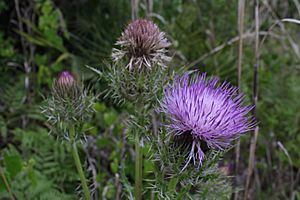Cirsium horridulum facts for kids
Quick facts for kids Cirsium horridulum |
|
|---|---|
 |
|
| Scientific classification | |
| Genus: |
Cirsium
|
| Species: |
horridulum
|
| Synonyms | |
|
Synonymy
Carduus horridulus Pers.
Carduus pinetorum Small Carduus spinosissimus Walter Carduus vittatus Small, syn of var. vittatum Cirsium chrismarii (Klatt) Petr. Cirsium pinetorum (Small) Small 1913 not Greenm. 1905 Cirsium vittatum (Small) Small, syn of var. vittatum Cnicus chrismarii Klatt Cnicus horridulus (Michx.) Pursh Cirsium megacanthum Nutt., syn of var. megacanthum Carduus smallii (Britton) H.E.Ahles, syn of var. vittatum Cirsium smallii Britton, syn of var. vittatum |
|
Cirsium horridulum, also known as bristly thistle or yellow thistle, is a plant found in North America. It belongs to the sunflower family. This plant can be an annual (meaning it lives for one year) or a biennial (meaning it lives for two years).
You can find Cirsium horridulum in the eastern and southern United States. Its range stretches from New England down to Florida, Texas, and Oklahoma. It also grows in Mexico, Belize, Guatemala, Honduras, and the Bahamas.
Contents
What Does Cirsium horridulum Look Like?
This thistle is a biennial herb that can grow very tall. It can reach up to 250 centimeters (about 8 feet) in height. It has a large main root that goes deep into the ground. It also has fleshy side roots that can sometimes grow new plants.
The leaves of Cirsium horridulum can be up to 40 centimeters (about 16 inches) long. They have thick, very sharp spines along their edges. The plant usually has several flower heads. These flower heads also have sharp spines.
The flowers themselves are called disc florets. They do not have the petal-like ray florets that some other plants in the sunflower family have. The color of the flowers can be different from one plant to another. You might see white, yellow, pink, red, or purple flowers.
Different Types of Cirsium horridulum
There are a few different types, or varieties, of Cirsium horridulum:
- Cirsium horridulum var. horridulum: This type grows from Maine all the way to Guatemala.
- Cirsium horridulum var. megacanthum: This type is found from the Florida Panhandle to Texas and Oklahoma. Thomas Nuttall, a famous botanist, once said this variety was "one of the most terribly armed plants in the genus" because of its many spines.
- Cirsium horridulum var. vittatum: This type grows from North Carolina to Louisiana.
Where is This Thistle Protected?
In some parts of the United States, Cirsium horridulum is a rare plant.
- It is considered endangered in Connecticut, New Hampshire, and Pennsylvania. This means it is at risk of disappearing from these states.
- It is listed as threatened in Rhode Island. This means it could become endangered if its situation does not improve.
Is it a Problem Plant?
The entire Cirsium group of plants, which includes Cirsium horridulum, is listed as a noxious weed in Arkansas and Iowa. A "noxious weed" is a plant that can harm crops, ecosystems, or people.
How People Have Used This Plant
Native American tribes have used Cirsium horridulum for different purposes.
- The Houma people made a special drink from the leaves and root of the plant mixed with whiskey. They used it to help clear phlegm from the lungs and throat. They also ate the soft, white inner parts of the plant raw.
- The Seminole people used parts of the plant to make darts for their blowguns.
What Animals Visit This Thistle?
Cirsium horridulum is an important plant for some insects.
- It is a host plant for the larvae (caterpillars) of the little metalmark butterfly.
- It is also a host plant for the larvae of the painted lady butterfly.
- The flowers of this thistle are very popular with many different butterflies and bumble bees. They visit the flowers to collect nectar.

